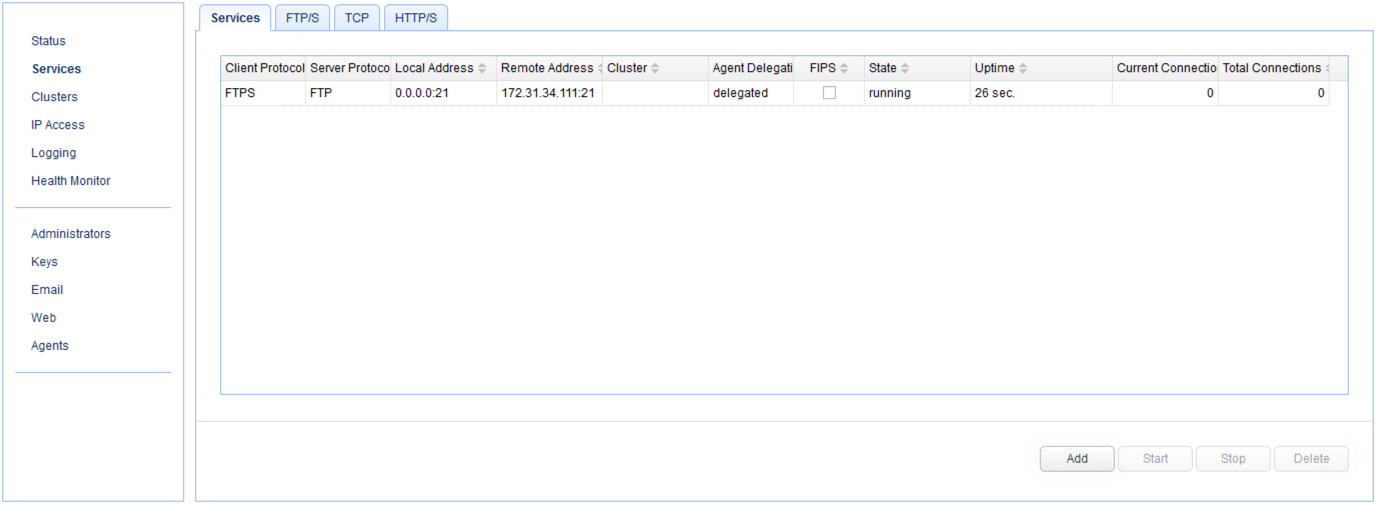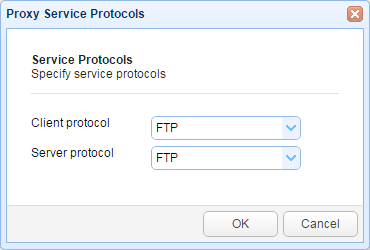A reverse proxy service is an IP/Host, Port and Protocol combination that accepts client FTP/S, TCP (e.g. SFTP) or HTTP/S connection requests. To view existing reverse proxy services click on the Services node. A list of services are displayed.
Figure 2

Client Protocol - The protocol used by the client to connect to the JSCAPE MFT Gateway Server. See Protocol types.
Server Protocol - The protocol used by the JSCAPE MFT Gateway Server to the remote host.
Local Host - The local IP that connections are accepted on.
Local Port - The local port that connections are accepted on.
Remote Address / Cluster - The remote host:port or cluster that connections are forwarded to.
Agent Delegation - Indicates whether connections are delegated to listening agents or handled by gateway directly.
State - The state of service (running, stopped).
Uptime - The total uptime since service start.
Current Connections - The current number of active connections.
Total Connections - The total number of connections since service start.
Protocol types
Client protocol |
Server protocol |
Description |
FTP |
FTP |
Forwards standard unencrypted FTP connections |
FTP |
Implicit FTPS |
Forwards standard unencrypted FTP connections to a target encrypted Implicit SSL FTP service |
FTP |
SFTP |
Forwards standard unencrypted FTP connections to a target SFTP service |
FTPS |
FTP |
Forwards encrypted Implicit SSL FTP connections to a target standard FTP service |
FTPS |
FTPS |
Forwards both standard unencrypted FTP connections and encrypted explicit SSL connections using AUTH TLS or AUTH SSL client commands |
FTPS |
SFTP |
Forwards both standard FTP connections and encrypted FTPS connections to a target SFTP service |
Implicit FTPS |
FTP |
Forwards encrypted implicit SSL FTP connections to a target FTP service |
Implicit FTPS |
Implicit FTPS |
Forwards only encrypted implicit SSL FTP connections |
Implicit FTPS |
SFTP |
Forwards encrypted implicit SSL FTP connections to a target SFTP service |
HTTP |
HTTP |
Forwards HTTP connections to a target HTTP service |
HTTP |
HTTPS |
Forwards HTTP connections to a target HTTPS service |
HTTPS |
HTTP |
Forwards encrypted HTTPS connections to a target HTTP service |
HTTPS |
HTTPS |
Forwards only encrypted HTTPS connections |
TCP |
TCP |
Forwards connections without any protocol translation performed (Read and Write) |
TCP |
TCP/SSL |
Forwards SSL encrypted connections without any protocol translation performed (Read and Write) |
TCP/SSL |
TCP |
Forwards SSL encrypted connections to any TCP service |
TCP/SSL |
TCP/SSL |
Forwards SSL encrypted connections without any protocol translation performed (Read and Write) |
SFTP/SSH |
SFTP/SSH |
Forwards SFTP/SSH connections |
SMTP |
SMTP |
Forwards plain SMTP connections |
POP3 |
POP3 |
Forwards plain POP3 connections |
IMAP4 |
IMAP4 |
Forwards plain IMAP4 connections |
MySQL |
MySQL |
Forwards plain MySQL connections |
UDP |
UDP |
Forwards connections without any protocol translation performed (Read and Write) |
Add service
To add a service, click the Add button.
When the next screen appears, select the Client protocol and Server protocol. Click OK to proceed.
Figure 55

Figure 3

Configure the following settings:
Local host - The local IP that connections are accepted on.
Local port - The local port that connections are accepted on.
Remote host - The remote host/IP that connections are forwarded to.
Remote port - The remote port that connections are forwarded to.
Cluster - The cluster to forward connections to. This is used for load balancing purposes.
Delegate connections to available agents - If checked then connections will be handled by connected agents rather than by gateway directly.
Ignore PASV/LPSV/EPSV IP of server host - Ignores the IP address returned by server when issuing PASV, LPSV or EPSV commands to server. Instead the IP address that gateway is connected to will be used. This is only applicable to FTP/S protocols.
See also